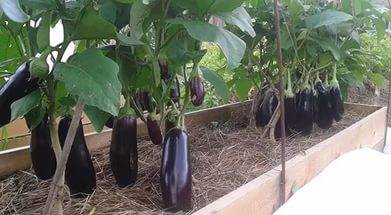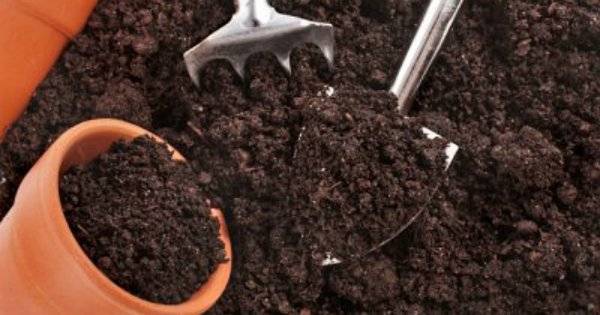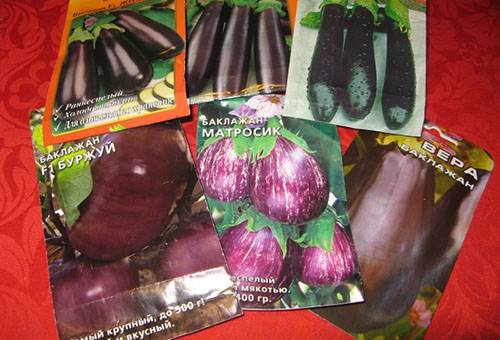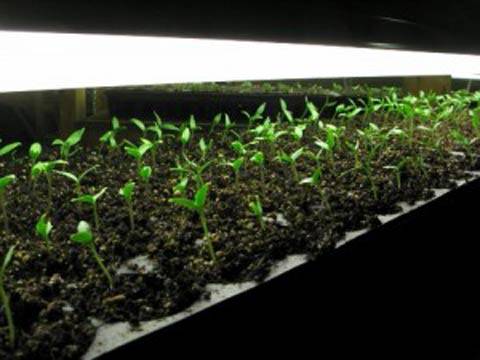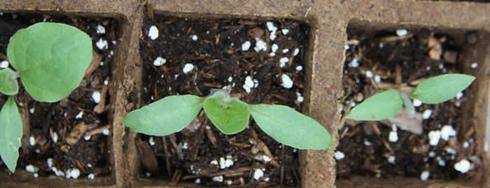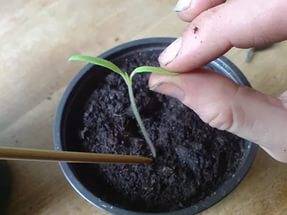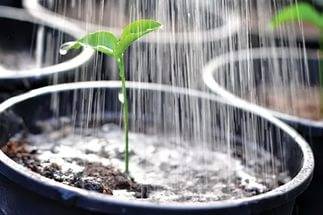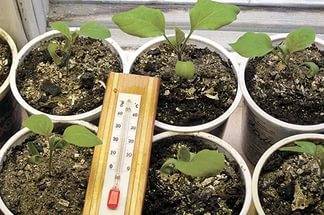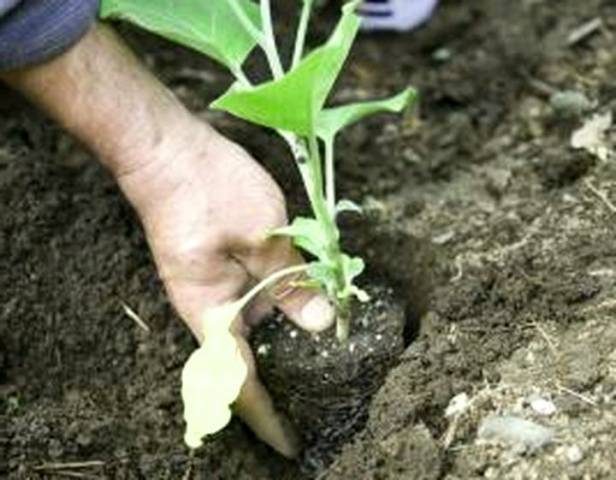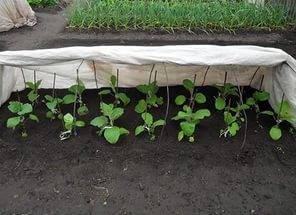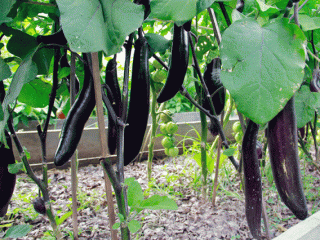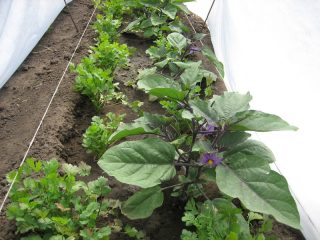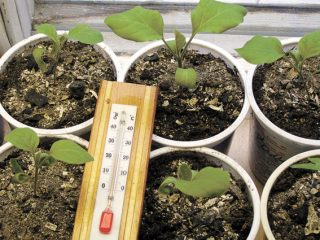Content
- 1 Preparing the soil for eggplant seedlings
- 2 Cooking eggplant seed material for planting
- 3 Sowing eggplant seeds in the ground
- 4 Organization of correct lighting of eggplant seedlings
- 5 Top dressing in the ground
- 6 Transplanting eggplant seedlings into large containers
- 7 Watering seedlings from the first days of her life
- 8 Hardening of seedlings
- 9 Planting seedlings in their permanent place
- 10 Care of planted seedlings
Eggplants, like many garden crops, love light, warmth, and regular watering. Young shoots are characterized by a slow rate of development, which is not suitable for growing in the climatic conditions of the middle zone. Growing seedlings will help to increase the survival rate and crop yield. First of all, it is necessary to select high-quality seed material, process and sow it. Further measures are aimed at caring for eggplant seedlings, on the correctness of which the development of plants depends.
Preparing the soil for eggplant seedlings
The intensity of plant development depends on the fertility of the soil. Soil for growing eggplant seedlings easier to buy at a specialized outlet. It is sold already with all the microelements introduced. Alternatively, you can easily prepare the soil yourself.
Loose soil will allow moisture and oxygen to penetrate the plant roots. It is important to disinfect the soil before sowing.
Self-preparation of the soil involves mixing 1 part of peat, 2 parts of humus and adding half of this total mass of wood shavings. You can improve the quality of clay soil by adding washed river sand. Not bad for eggplant seedlings is suitable land from the garden, where cabbage or cucumbers used to grow. Disinfect the soil with boiling water. There are 2 ways here:
- the ground is poured with boiling water with densely dissolved manganese;
- the prepared soil is steamed with a sieve over boiling water for 30 minutes.
The simplest preparations are suitable for feeding. Wood ash is easy to cook on your own, burned a few logs. In the store, you only have to buy potassium, superphosphate and urea.
Cooking eggplant seed material for planting
The eggplant kernels begin to be prepared long before they sowing... It is important to decide on the place of planting seedlings in order to roughly know the timing of preparation and sowing of seeds. If the planting of plants is supposed to be in the garden under the film, then the sowing falls in the third decade of March. For greenhouse eggplant cultivation, sowing can be started in the third decade of February or early March.
The preparation of seed material provides for their disinfection. Eggplant grains are immersed in a saturated solution of potassium permanganate for half an hour, and then washed with clean water. The next treatment is aimed at accelerated germination. As growth stimulants, you can take store solutions or prepare yourself from 1 liter of water + 0.5 kg of boric acid. Good results are shown by a solution of 1 liter of water + 100 ml of aloe juice.
Germination will help speed up sprouting and protect yourself from sowing empty grains. Eggplant seeds are wrapped in wet cotton cloth or gauze, placed on a saucer, covered with foil and placed in a warm place with a temperature of 25aboutFROM.
Sowing eggplant seeds in the ground
Small round or square plastic cups are ideal for sowing eggplant seeds.You cannot save here, and it is better to plant 3 seeds in each container. When the eggplant seeds germinate, two weak shoots are removed, and the strong ones are left to grow. Before sowing, the soil is watered in cups. You can take plain tap water, stand it for a couple of days and dissolve a few manganese crystals until a pale solution is obtained.
The sprouted seed is carefully buried into the ground to a depth of about 2 cm. Watering the ground is no longer necessary, just cover all the sown cups with foil and put them in a warm place. The sown germinated grains will hatch after 5 days. If the seeds were unprepared dry, seedlings should be expected for 10 days. After the amicable manifestation of seedlings, the film is removed from the cups and taken out to a cooler place. However, you cannot overdo it. The temperature where the eggplant seedlings will grow further should be a maximum of 5aboutC below from the place where the cups with seeds stood immediately after sowing.
Organization of correct lighting of eggplant seedlings
Sprouted young eggplant sprouts from the first days must be provided with intense lighting. Most of them get through the window, however, this is not enough for seedlings of early February sowing. Winter daylight hours are short, and it is not enough for the full development of the plant. The problem can be solved by arranging artificial lighting.
Simple incandescent bulbs will not work here. The best results are shown by fluorescent and LED paws or their combination. There is practically no heat emanating from them, but the lamps give a lot of light. It is important to maintain the maximum proximity of the light source to the plant, which is 150 mm. Lighting is turned on about 2 hours before dawn, as well as with the onset of darkness in the evening. The time for turning on and off the lamps is easy to calculate, based on the fact that daylight hours for eggplant seedlings should last at least 14 hours. A decrease in the duration of illumination threatens poor development of seedlings and late formation of buds.
It is recommended to turn on the lamps several hours before dawn and after sunset, thereby increasing the duration of daylight hours to 14 hours. Otherwise, eggplant seedlings develop less intensively, and flower buds on it will be tied much later.
Top dressing in the ground
It is important to support young shoots at the initial stage of their growth. First time eggplant seedlings are fed after the appearance of two full sheets. You can wait until the third leaf grows. For feeding, make a solution of 1 liter of water, 1 g of potassium, 1 tsp. wood ash, 0.5 tsp. nitrate and 4 g of superphosphate.
The second time the seedlings are fed with organic fertilizers 10 days after the first feeding. Eggplant seedlings react to organic matter instantly, and after 3 days they intensively grow. For the second feeding, you will need to prepare a solution of 1 part of fermented chicken droppings and 15 parts of water.
The third feeding is considered the main one, which is performed 1 week before planting eggplant seedlings in the ground. Usually vegetable growers use superphosphate. This fertilizer is poorly soluble in water, so the solution is prepared in advance. For 1 liter of hot water, dilute 1 tbsp. l. fertilizers, and periodically stirring this liquid, wait about 1 day until the superphosphate is completely dissolved. The next day, a clean layer of water should form on top of the jar, which must be drained. The remaining saturated solution is diluted at the rate of 1 tsp.on a bucket of water, and feed eggplant seedlings.
Transplanting eggplant seedlings into large containers
If initially the sowing of seeds was carried out in small containers with a diameter of up to 50 mm, after about a month there will be little space for the matured plants and they are transplanted into large glasses. Tanks with a diameter of 80 mm and a wall height of up to 100 mm are ideal. In order not to damage the root system, the seedlings are watered abundantly before transplanting. By turning the cup over, the plant will easily come out along with a lump of earth. It remains to place it in a new large container with earth, and then carefully sprinkle it with loose soil on top.
Transplanted eggplant seedlings in large glasses, they are placed on the windowsill, while the glass is covered with white paper for 2 days. During this period, the plant requires moderate lighting.
Watering seedlings from the first days of her life
When growing eggplant seedlings it must be remembered that newly hatched sprouts do not require watering. It is enough to moisten a slightly dried soil from a sprayer with warm, settled water. The first time the germinated seedlings are watered on the third day. The interval for further watering is set after 5 days. It is best to water the seedlings before lunchtime at about 11 o'clock in the afternoon. It is important not to wet the delicate leaves of the plants and not to pour the soil before the formation of silt.
If the soil dries out faster from the high temperature in the room, the seedlings are watered after 3 days. It is important to loosen the soil under each plant for oxygen access.
Hardening of seedlings
Indoor culture is very gentle and not immediately adapted for street planting. Plants need adaptation to the external environment, which is achieved by hardening. The hardening process begins about 2 weeks before planting in the ground. Eggplant seedlings are taken out for a short time in a cold veranda or on a balcony, increasing the time of stay every day. If there is a greenhouse, the seedlings for hardening can be taken out at the end of April. However, night frosts will still negatively affect the plants, so they are covered overnight with an additional structure with an awning. In the afternoon, the cover is removed.
Planting seedlings in their permanent place
The planting time of seedlings depends on the place of their cultivation. By this time, the plant should have formed from 8 to 12 full leaves. When growing eggplants in a greenhouse, planting seedlings start from May 5. The same numbers are adhered to when planting in open ground in the southern regions. For the northern and steppe regions, the optimal landing time is considered to be the middle and end of May, but it all depends on the weather conditions.
During planting, each plant is carefully removed from the cup so as not to disturb the lump of soil with the root system. Thus, the seedlings take root faster and immediately grow. Potted plants will yield 25 days earlier eggplant than box-grown seedlings. When planting, the distance between the rows is observed - 700 mm, the pitch of each plant is 250 mm. If the seedlings were grown in a box, the plants are carefully removed and buried 80 mm. Here you need to pay attention that the root collar is buried by 15 mm. After planting, watering is performed for each seedling.
Care of planted seedlings
4 days after planting eggplant seedlings in the ground, all plants are examined. If there is a poor survival rate in some or the seedlings, in general, have dried up, new plants are planted in their place.
In summer, eggplants are watered after about 9 days. In drought conditions, the intensity of watering can be increased. After each watering, be sure to plow the soil to a depth of 80 mm. On the 20th day after planting, the first top dressing should be made from 100 g of urea per 10 m2... The second time is fed after 3 weeks after the first fertilization. On the same area, 150 g of superphosphate and 100 g of urea are buried in the ground with a hoe, after which the beds are watered.
The video shows the care of seedlings:
If done correctly initially, healthy seedlings will yield a good eggplant crop.It is only important to protect the culture from the Colorado potato beetle, which is very fond of eating it.
